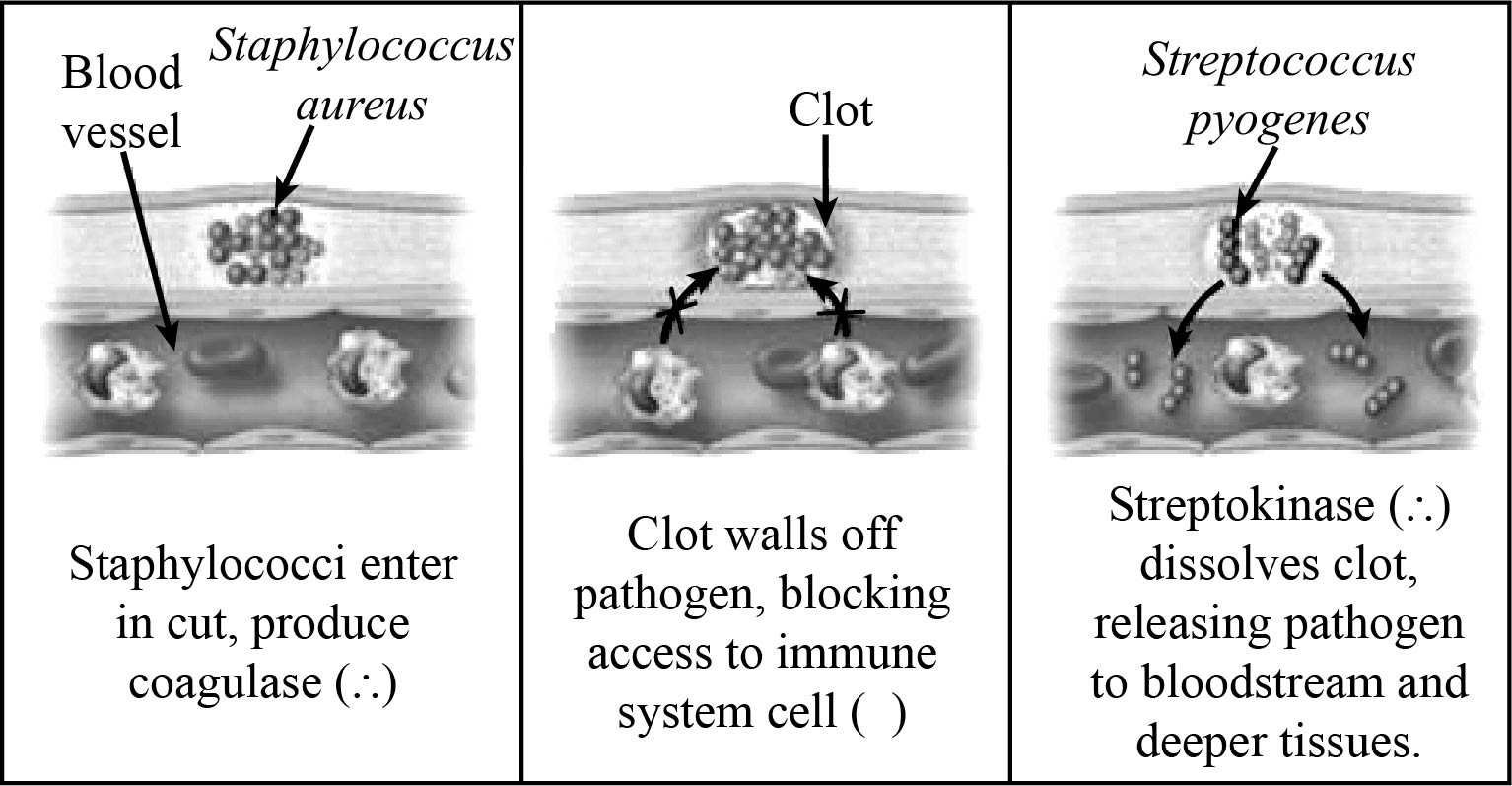
Concept explainers
Coagulase is a virulence factor for Staphylococcus aureus that acts by causing clot formation at the site of S. aureus growth. Streptokinase is a virulence factor for Streptococcus pyogenes that acts by dissolving clots at the site of S. pyogenes growth. Reconcile these opposing strategies for enhancing pathogenicity.
To explain:
The virulent effect of coagulase and streptokinase for enhancing pathogenicity.
Concept introduction:
Coagulase and streptokinase are the virulence factors released by Staphylococcus aureus and Streptococcus pyogenes respectively. Coagulase helps in the process of clot formation thereby protecting the colony of S. aureus cells from the host immune response. Streptokinase helps in dissolving the clot for the further spread and growth of the micro-organism. Coagulase and streptokinase works antagonistically in the process of blood clotting.
Explanation of Solution
Pictorial representation: The figure depicting the action of Coagulase and Streptokinase is represented as follows:

Fig.1: The mode of action of Coagulase and Streptokinase.
Staphylococcus aureus enters the wound and help in the conversion of “fibrinogen to fibrin” thereby resulting the formation of clot and protection of S. aureus cells. Streptokinase released by Streptococcus pyogenes help in dissolving the clot and spreading the proliferation of the microorganism in different cells and tissues.
The antagonistic nature of these two virulence factors can be used to enhance the rate of pathogenicity in a particular cell or tissue of an individual. In the case of coagulase, a protection cover is generated with the help of fibrin that prevents the further action of drugs and does not allow the process of phagocytosis. In streptokinase, the fibrin/clot is dissolved leading to growth and spread of microorganism resulting in the spread of infection to other part of cells.
Hence, these two virulence factors work antagonistically to increase the process of pathogenicity in an individual.
Want to see more full solutions like this?
Chapter 25 Solutions
EBK BROCK BIOLOGY OF MICROORGANISMS
- How is a protein destined for the Endoplasmic Reticulum (ER), imported into the ER? Be concise.arrow_forwardFind out about the organisations and the movements aimed at the conservation of our natural resources. Eg Chipko movement and Greenpeace. Make a project report on such an organisation.arrow_forwardWhat are biofertilizers and mention the significancearrow_forward
- PCBs and River Otters: Otters in Washington State’s Green-Duwamish River have high levels of polychlorinated biphenyls (PCBs) in their livers. PCBs can bind to the estrogen receptors in animals and disrupt the endocrine system of these otters. The PCBs seem to increase the estrogen to androgen ratio, skewing the ratio toward too much estrogen. How would increased estrogen affect the river otter population? Based on your reading of the materials in this unit, what factors can affect fertility in humans? Explain how each of the factors affecting human fertility that you described can disrupt the human endocrine system to affect reproduction.arrow_forwardOther than oil and alcohol, are there other liquids you could compare to water (that are liquid at room temperature)? How is water unique compared to these other liquids? What follow-up experiment would you like to do, and how would you relate it to your life?arrow_forwardSelection of Traits What adaptations do scavengers have for locating and feeding on prey? What adaptations do predators have for capturing and consuming prey?arrow_forward
- Competition Between Species What natural processes limit populations from growing too large? What are some resources organisms can compete over in their natural habitat?arrow_forwardSpecies Interactions Explain how predators, prey and scavengers interact. Explain whether predators and scavengers are necessary or beneficial for an ecosystem.arrow_forwardmagine that you are conducting research on fruit type and seed dispersal. You submitted a paper to a peer-reviewed journal that addresses the factors that impact fruit type and seed dispersal mechanisms in plants of Central America. The editor of the journal communicates that your paper may be published if you make ‘minor revisions’ to the document. Describe two characteristics that you would expect in seeds that are dispersed by the wind. Contrast this with what you would expect for seeds that are gathered, buried or eaten by animals, and explain why they are different. (Editor’s note: Providing this information in your discussion will help readers to consider the significance of the research).arrow_forward
 Microbiology for Surgical Technologists (MindTap ...BiologyISBN:9781111306663Author:Margaret Rodriguez, Paul PricePublisher:Cengage Learning
Microbiology for Surgical Technologists (MindTap ...BiologyISBN:9781111306663Author:Margaret Rodriguez, Paul PricePublisher:Cengage Learning Comprehensive Medical Assisting: Administrative a...NursingISBN:9781305964792Author:Wilburta Q. Lindh, Carol D. Tamparo, Barbara M. Dahl, Julie Morris, Cindy CorreaPublisher:Cengage Learning
Comprehensive Medical Assisting: Administrative a...NursingISBN:9781305964792Author:Wilburta Q. Lindh, Carol D. Tamparo, Barbara M. Dahl, Julie Morris, Cindy CorreaPublisher:Cengage Learning Biology (MindTap Course List)BiologyISBN:9781337392938Author:Eldra Solomon, Charles Martin, Diana W. Martin, Linda R. BergPublisher:Cengage Learning
Biology (MindTap Course List)BiologyISBN:9781337392938Author:Eldra Solomon, Charles Martin, Diana W. Martin, Linda R. BergPublisher:Cengage Learning





